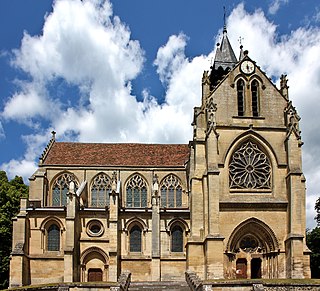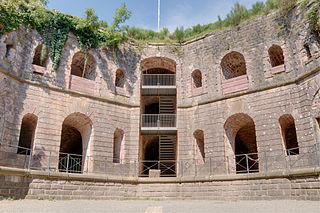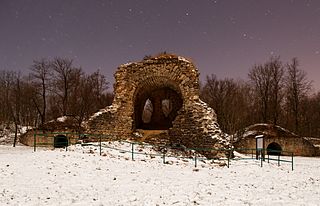
The French Air and Space Force (AAE) is the air and space force of the French Armed Forces. Formed in 1909 as the Service Aéronautique, a service arm of the French Army, it became an independent military branch in 1934 as the French Air Force. On 10 September 2020, it assumed its current name, the French Air and Space Force, to reflect an "evolution of its mission" into the area of outer space.

Taverny is a commune in the northwestern suburbs of Paris, France. It is located 21.2 km (13.2 mi) from the center of Paris.

Taverny Air Base is located in the communities of Taverny and Bessancourt in the Val d'Oise département of France, twenty kilometers north of Paris. Until 2011 it was the headquarters of the French Air Force nuclear strike force, with an underground command center.

Fort d'Ivry was built in the Paris suburb of Ivry-sur-Seine between 1841 and 1845, as one of the forts in a ring of strong points surrounding Paris. The fort is about 1 kilometre outside the Thiers Wall, built by the same program in response to a perception that Paris was vulnerable to invasion and occupation. The fort was upgraded in the 1870s, to cope with improvements in artillery performance as part of the Séré de Rivières system. In 1946, the fort was vacated by the garrison. It is now the home of the Communication and Audiovisual Production Company for the Department of Defense.

Fort de Champigny was built following the Franco-Prussian War to defend Paris. Located to the southeast of Paris in Chennevières-sur-Marne, the fort was part of an outer ring of fortifications built in response to improvements in the range and effectiveness of artillery since the construction of the Thiers fortifications of the 1840s. It was built in accordance with improved principles of fortification developed for the Séré de Rivières system.

Fort du Salbert, also known as Fort Lefebvre, was built between 1874 and 1877. It was named after General François Joseph Lefebvre. It forms part of the Séré de Rivières system fortifications in the fortified region of Belfort in northeastern France. It is located at the summit of Salbert hill to the northwest of Belfort. During the early years of the Cold War it briefly served as an air defense coordination center.

Fort de Giromagny, also known as Fort Dorsner, was built near Belfort in northeastern France between 1875 and 1879. The fort forms the southern end of the defensive curtain of the Haute Moselle Region, abutting the fortified region of Belfort, which lies to its south. The Haute Moselle defenses form a link between the fortified encampments of Épinal and Belfort. The fort overlooks the main roads to the northeast of Belfort, which form a crossroads at Giromagny.

Fort du Mont Bart is located to the south of Montbéliard, France. It was built between November 1874 and July 1877 as part of the Séré de Rivières system of fortifications. The fort overlooks the valleys of the Doubs and the Allan at an elevation of 497 metres (1,631 ft), standing to the south and rear of the fortified region of Belfort and in control of the road to Besançon. The fort was intended to augment the Belfort fortifications and to prevent an enemy from bypassing them. The most striking feature of the Fort du Mont Bart is its "interior street", originally constructed in the open air as a sunken court, then covered before World War I with reinforced concrete.

The Fort des Adelphes, or Fort Richepance, is part of the fortifications of Épinal. It was built near the village of Deyvillers between 1883 and 1885, and was modernized beginning in 1907. It is an example of a Séré de Rivières system fortification. During World War II the fort surrendered to German forces and was then used by the Germans to fire on neighboring forts Longchamp and Dogneville. The fort is now occupied by an activity of the French Air Force associated with Base aerienne 133 Nancy-Ochey and is not accessible to the public.
The Fort de Plappeville, or Feste Alvensleben, is a military fortification located to the northwest of Metz in the commune of Plappeville. As part of the first ring of the fortifications of Metz, it is an early example of a Séré de Rivières system fort. While it did not see action during World War I, it was the scene of heavy fighting between American forces and German defenders at the end of the Battle of Metz, in 1944. After Second World War it became a training center for the French Air Force. Fort 'Alvensleben' has been abandoned since 1995.

The Fort de Leveau, also known as Fort Schouller, is located in the commune of Feignies, France. It is part of the fortifications of Maubeuge, located to the northwest of the city, overlooking the railroad to Mons. The Séré de Rivières system fort was built 1882–1884, one of six forts built at the time. It is maintained as a museum by the town of Feignies.

The Fort de l'Infernet is a fortification complex near Briançon in the French Alps. It was built as part of the Séré de Rivières system of fortifications in 1876–78 to defend France against invasion from Italy. It specifically overlooks the valley of the Durance behind and the Fort du Gondran, closer to Italy. Built at an elevation of 2,380 metres (7,810 ft), the fort was accessed by an aerial tramway, which connected to the older Fort du Randouillet at lower elevation. It was the last French fort to be built from cut stone masonry.

The Fort de Bourlémont, or Fort Choiseul, was built between 1878 and 1881. The fort was built as part of the Séré de Rivières system of fortifications, which were conceived in response to the increasing power and range of artillery. The Fort de Bourlémont was part of the defenses of the Charmes Gap, in the town of Mont-lès-Neufchâteau, 3 kilometres (1.9 mi) west of Neufchâteau.
The Fort de Condé, or Fort Pille, is a fortification of the Séré de Rivières system, built in France between 1877 and 1883 to defend the area between Soissons and Laon. It is located on the heights of the confluence of the Aisne and the Vesle near the communes of Condé-sur-Aisne and Chivres-Val. Although the fort was considered obsolete at the start of World War I, its command of strategic ground made it a coveted objective throughout the war, changing hands several times. Following the war it was used in support service before its abandonment and purchase by a local community. It has been under preservation since 1979 and may be visited.

The Fort de Domont was built following the Franco-Prussian War to defend Paris. Located to the north of Paris in Domont, the fort was part of an outer ring of fortifications built in response to improvements in the range and effectiveness of artillery since the construction of the Thiers fortifications of the 1840s. It was built between 1875 and 1879 in accordance with improved principles of fortification developed for the Séré de Rivières system. Work on the fort began in 1874 and were completed in 1878. The fort covered an area of 12 hectares and its garrison comprised 1175 men and officers.
The Strategic Air Forces (FAS) is a command of the French Air and Space Force. It was created on January 14, 1964, and directs France's nuclear bombardment force.














